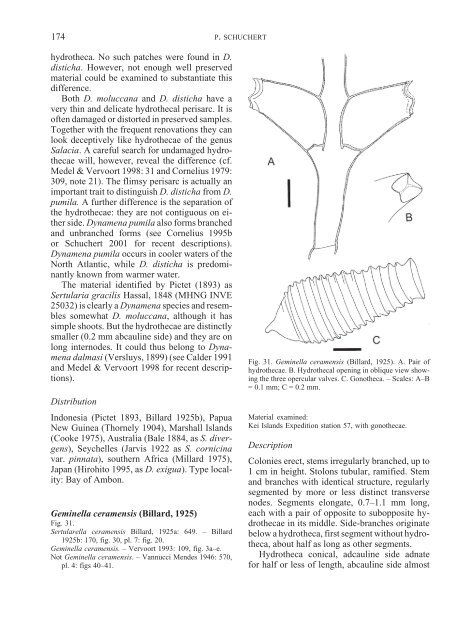Hydroids (Cnidaria, Hydrozoa) of the Danish expedition to
Hydroids (Cnidaria, Hydrozoa) of the Danish expedition to
Hydroids (Cnidaria, Hydrozoa) of the Danish expedition to
Create successful ePaper yourself
Turn your PDF publications into a flip-book with our unique Google optimized e-Paper software.
174<br />
hydro<strong>the</strong>ca. No such patches were found in D.<br />
disticha. However, not enough well preserved<br />
material could be examined <strong>to</strong> substantiate this<br />
difference.<br />
Both D. moluccana and D. disticha have a<br />
very thin and delicate hydro<strong>the</strong>cal perisarc. It is<br />
<strong>of</strong>ten damaged or dis<strong>to</strong>rted in preserved samples.<br />
Toge<strong>the</strong>r with <strong>the</strong> frequent renovations <strong>the</strong>y can<br />
look deceptively like hydro<strong>the</strong>cae <strong>of</strong> <strong>the</strong> genus<br />
Salacia. A careful search for undamaged hydro<strong>the</strong>cae<br />
will, however, reveal <strong>the</strong> difference (cf.<br />
Medel & Vervoort 1998: 31 and Cornelius 1979:<br />
309, note 21). The flimsy perisarc is actually an<br />
important trait <strong>to</strong> distinguish D. disticha from D.<br />
pumila. A fur<strong>the</strong>r difference is <strong>the</strong> separation <strong>of</strong><br />
<strong>the</strong> hydro<strong>the</strong>cae: <strong>the</strong>y are not contiguous on ei<strong>the</strong>r<br />
side. Dynamena pumila also forms branched<br />
and unbranched forms (see Cornelius 1995b<br />
or Schuchert 2001 for recent descriptions).<br />
Dynamena pumila occurs in cooler waters <strong>of</strong> <strong>the</strong><br />
North Atlantic, while D. disticha is predominantly<br />
known from warmer water.<br />
The material identified by Pictet (1893) as<br />
Sertularia gracilis Hassal, 1848 (MHNG INVE<br />
25032) is clearly a Dynamena species and resembles<br />
somewhat D. moluccana, although it has<br />
simple shoots. But <strong>the</strong> hydro<strong>the</strong>cae are distinctly<br />
smaller (0.2 mm abcauline side) and <strong>the</strong>y are on<br />
long internodes. It could thus belong <strong>to</strong> Dynamena<br />
dalmasi (Versluys, 1899) (see Calder 1991<br />
and Medel & Vervoort 1998 for recent descriptions).<br />
Distribution<br />
Indonesia (Pictet 1893, Billard 1925b), Papua<br />
New Guinea (Thornely 1904), Marshall Islands<br />
(Cooke 1975), Australia (Bale 1884, as S. divergens),<br />
Seychelles (Jarvis 1922 as S. cornicina<br />
var. pinnata), sou<strong>the</strong>rn Africa (Millard 1975),<br />
Japan (Hirohi<strong>to</strong> 1995, as D. exigua). Type locality:<br />
Bay <strong>of</strong> Ambon.<br />
Geminella ceramensis (Billard, 1925)<br />
Fig. 31.<br />
Sertularella ceramensis Billard, 1925a: 649. – Billard<br />
1925b: 170, fig. 30, pl. 7: fig. 20.<br />
Geminella ceramensis. – Vervoort 1993: 109, fig. 3a–e.<br />
Not Geminella ceramensis. – Vannucci Mendes 1946: 570,<br />
pl. 4: figs 40–41.<br />
P. SCHUCHERT<br />
Fig. 31. Geminella ceramensis (Billard, 1925). A. Pair <strong>of</strong><br />
hydro<strong>the</strong>cae. B. Hydro<strong>the</strong>cal opening in oblique view showing<br />
<strong>the</strong> three opercular valves. C. Gono<strong>the</strong>ca. – Scales: A–B<br />
= 0.1 mm; C = 0.2 mm.<br />
Material examined:<br />
Kei Islands Expedition station 57, with gono<strong>the</strong>cae.<br />
Description<br />
Colonies erect, stems irregularly branched, up <strong>to</strong><br />
1 cm in height. S<strong>to</strong>lons tubular, ramified. Stem<br />
and branches with identical structure, regularly<br />
segmented by more or less distinct transverse<br />
nodes. Segments elongate, 0.7–1.1 mm long,<br />
each with a pair <strong>of</strong> opposite <strong>to</strong> subopposite hydro<strong>the</strong>cae<br />
in its middle. Side-branches originate<br />
below a hydro<strong>the</strong>ca, first segment without hydro<strong>the</strong>ca,<br />
about half as long as o<strong>the</strong>r segments.<br />
Hydro<strong>the</strong>ca conical, adcauline side adnate<br />
for half or less <strong>of</strong> length, abcauline side almost

















